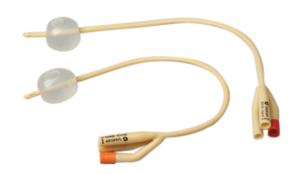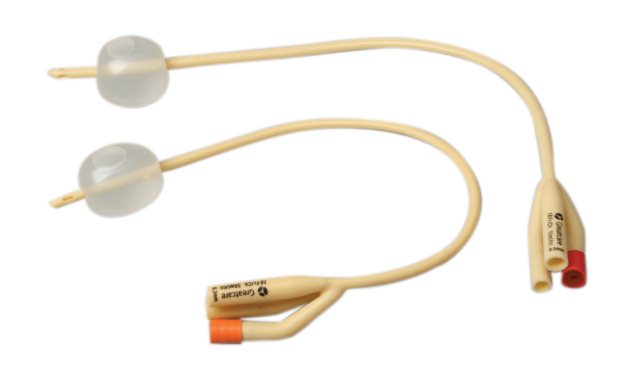Foley Balloon Catheter
Foley Balloon Catheter Two Way is a medical device that helps you to breathe more easily in difficult environments. This catheter has a special design that makes it easier for you to breathe, and it comes with a tiemann (plastic valve) that makes the delivery of the balloon easy.
Description
- Three Way, Standard (rubber valve)
- Extra lumen for irrigation and drug delivery.
- Balloon capacity: 10ml, 15ml, 30ml or 50ml available.
- Length: 400mm.
| Ref. No.: |
Size: |
Balloon capacity: |
Color: |
Qty.Cs: |
| NMU200416 |
16 Fr / Ch |
30ML |
Orange |
400 |
| NMU200418 |
18 Fr/ch |
30ML |
Red |
400 |
| NMU200420 |
20 Fr/ch |
30ML |
Yellow |
400 |
| NMU200422 |
22 Fr/ch |
30ML |
violet |
400 |
| NMU200424 |
24 Fr/ch |
30ML |
Blue |
400 |
| NMU200426 |
26 Fr/ch |
30ML |
Pink |
400 |
Foley Balloon Catheter
Foley Balloon Catheter is a medical device that helps you to breathe more easily in difficult environments. This catheter has a special design that makes it easier for you to breathe, and it comes with a tiemann (plastic valve) that makes the delivery of the balloon easy.
What is the Foley Balloon Catheter?
The Foley Balloon Catheter is a catheter that uses a balloon to help maintain blood flow and relieve pressure in the chest. The Tiemann (plastic valve) makes it easier to use.
How does the Foley Balloon Catheter work?
The Foley Balloon Catheter is a two-way catheter that uses a balloon to inflate the lumen of the catheter. This increases the flow of blood through the catheter and allows for easier access to critical areas. The Tiemann (plastic valve) helps control air pressure in the balloon, which helps to maintain an accurate inflation of the balloon and prevents over-inflation.
What are the benefits of the Foley Balloon Catheter?
The Foley Balloon Catheter is a two way catheter that uses a plastic valve to help prevent air from entering the catheter. This type of catheter can be used for a variety of procedures, including diagnostic tests, surgery and interventional radiology. The benefits of using a Foley Balloon Catheter include: improved patient comfort and reduced anxiety; reduced risk of infection; and reduced risk of complications.
What are the risks of the Foley Balloon Catheter?
The risks of the Foley Balloon Catheter include infection, bleeding, and air embolism. Infection can occur if the catheter becomes contaminated with bacteria or if the catheter is inserted into an area of the body where there is a lot of bacteria, such as the rectum or vagina. Bleeding can occur if the valve fails, if the catheter becomes blocked, or if the catheter falls out. Air embolism can happen when air bubbles formed by blood flow get trapped in the balloon, causing blockage of blood vessels.
How to use the Foley Balloon Catheter?
If you are looking for a way to provide more comfortable and efficient care to your patients, the Foley Balloon Catheter may be what you are looking for. This particular catheter is made with a plastic valve that helps to prevent air bubbles from forming during use, which can lead to improved patient comfort. Here are some tips on how to use this device:
1. First, make sure that the patient is adequately hydrated before procedure. This will help maintain healthy blood flow and reduce the risk of complications.
2. Clean the skin around the catheter insertion site with alcohol or hydrogen peroxide before insertion. This will help to avoid infection and irritation.
3. After cleaning the area, insert the catheter into the desired location using gentle pressure. Do not pull on the catheter excessively - this could cause damage or leakage.
4. Once in place, inflate the balloon using a syringe or pump until it is firm and inches away from the skin (do not over-inflate). Doing so may cause pain or discomfort for the patient.
5. To remove the balloon, slowly deflate it using a syringe or pump
What are some other uses for the Foley Balloon Catheter?
The Foley Balloon Catheter is a two-way catheter that can be used for a variety of medical procedures. The Tiemann (plastic valve) allows for smooth, uninterrupted passage through the balloon catheter. This makes it ideal for procedures such as endoscopic retrograde cholangiopancreatography (ERCP), which is a procedure used to diagnose and treat pancreatic diseases. The Tiemann also makes the Foley Balloon Catheter less likely to cause embolism, which can lead to serious complications.
Balloon Catheter, the inflatable will not empty. This issue happens all the more usually in patients with long haul Foley catheters. Despite the fact that we have all seen nursing home patients present with penile draining in the wake of taking out their Foley catheter with the inflatable still swelled, that is clearly impossible for crisis doctors. The issue is that the hard-headed inflatable is sitting far off, somewhere down in the urinary bladder.
The reason for the inflatable breakdown can be anyplace along the catheter, however it's normally found in the inflatable expansion port, the inflatable waste channel, or the inflatable itself. A usually announced reason for the issue is utilizing saline to extend the inflatable. With time, salt gems from the saline encourage in the different areas liable for emptying disappointment.
Foley Balloon Catheter
A urologist named Frederic Foley, MD, fostered his eponymous catheter in the last part of the 1920s and mid 1930s. It was initially an open framework, yet was transformed into a shut framework with a sack during the 1950s. I presume that we are essentially acquainted with the catheter parts, which incorporate the inflatable expansion port, the pee waste port, the inflatable to moor the catheter in the bladder, and the tip or bladder opening.
Catheters can be made of elastic, plastic, or silicone. The inflatable volumes range between 5 mL and 30 mL. There are additionally straight single-use catheters, the bended or coudé catheter, and a three-way Foley catheter for overseeing meds or water system. Catheters come in various distances across, and is estimated utilizing the French scale or French check framework. It is normally contracted as Fr, however different varieties, including CH or Ch for the framework's innovator Joseph-Frédéric-Benoît Charrière can be utilized. The higher the number, the bigger the catheter measurement, and 3 Fr is equivalent to 1 mm. So a 24 Fr catheter estimates 8 mm in outer distance across. The scope of sizes commonly accessible are as per the following: 5 Fr, 6 Fr, 8 Fr, 10 Fr, 12 Fr, 14 Fr, 16 Fr, 18 Fr, 20 Fr, 22 Fr, 24 Fr, and 26 Fr.
Dealing with the Failure to Deflate
Dealing with a Foley inflatable's inability to collapse remembers tending to the expected locales of block for either the inflatable expansion port, the inflatable seepage channel, or the inflatable. Thus, the methods utilized include waste port and channel the executives or inflatable annihilation. Various procedures have been accounted for in the writing, yet I will zero in on those generally functional for crisis doctors. Having a ultrasound machine accessible to imagine the inflatable would be incredibly helpful with the vast majority of the accompanying methods.
Consider and Manage Balloon Cuffing
The inability to eliminate a Foley catheter may not be brought about by disappointment of the inflatable to collapse. All things being equal, it very well may be brought about by swell binding, where the inflatable flattens however neglects to empty flush with the catheter. All things considered, a circumferential raised sleeve endures at the inflatable equator and makes catheter expulsion almost incomprehensible. This is helped by putting 0.5 to 1.0 mL of water into the inflatable to streamline the shape of the inflatable, permitting ensuing evacuation.
Evacuation of the Balloon Inflation Port
The initial phase in endeavoring to flatten a Foley expand is regularly removing the expansion port with some scissors. The inflatable will expeditiously flatten assuming the check includes a faulty expansion port. The water from the inflatable will be noticed dribbling from the expansion port.

Guidewire Application
When the expansion port has been eliminated, the channel is presently accessible for embedding a greased up guidewire. A guidewire from a focal line pack or ureteric guidewire can be utilized with its floppy end first to attempt to clear the seepage channel of any flotsam and jetsam. In the event that this doesn't work, the guidewire can be utilized to penetrate the inflatable. In the wake of imparting 200 mL of water into the bladder, embed the firm finish of the guidewire to penetrate the inflatable. Filling the bladder with water secures it against bladder injury on the off chance that the inflatable blasts as opposed to depleting gradually.
Swell Overinflation and Rupture
This procedure is for the most part deterred on the grounds that bladder injury can happen and expand pieces can stay in the bladder requiring evacuation by cystoscopy. It includes putting an intravenous catheter into the seepage channel of the Foley catheter (after the expansion port expulsion) and ingraining water under tension. Once more, wounds to the bladder have been accounted for, and undesirable inflatable sections are practically ensured.
Direct Puncture of the Balloon Catheter
Percutaneous suprapubic cut of the inflatable utilizing ultrasound direction is another choice. The inflatable is carried into close contact with the bladder divider, and a ultrasound-directed percutaneous suprapubic cut is refined. Different strategies portray vaginal, transurethral, or transrectal approaches, yet these are in all likelihood outside the extent of crisis doctors. Once more, any time an inflatable cut strategy is refined, investigate the inflatable after catheter evacuation to survey for missing pieces. On the off chance that a part of the inflatable is feeling the loss of, a resulting cystoscopy is suggested.
Substance Deflation of the Balloon Catheter
The utilization of synthetic compounds, for example, CH3)2CO has been accounted for, yet mineral oil is likely the most secure. The strategy includes imparting 10 mL of mineral oil into the inflatable expansion lumen. On the off chance that inflatable burst doesn't happen shortly, the technique is rehashed. CH3)2CO and mineral oil can require a few hours to burst the inflatable. These synthetics can be aggravating to the bladder, and another Foley ought to be put after the inflatable is collapsed to inundate the bladder to eliminate them. It is prescribed that the bladder be completely filled with typical saline before substance collapse is attempted.
Disappointment of the Foley inflatable to flatten is a generally intriguing occasion, yet it tends to be very perturbing when it occurs. In the wake of watching the current month's video and investigating the choices examined above, you can have confidence that you presently have every one of the
instruments important to effectively resolve this crisis.
